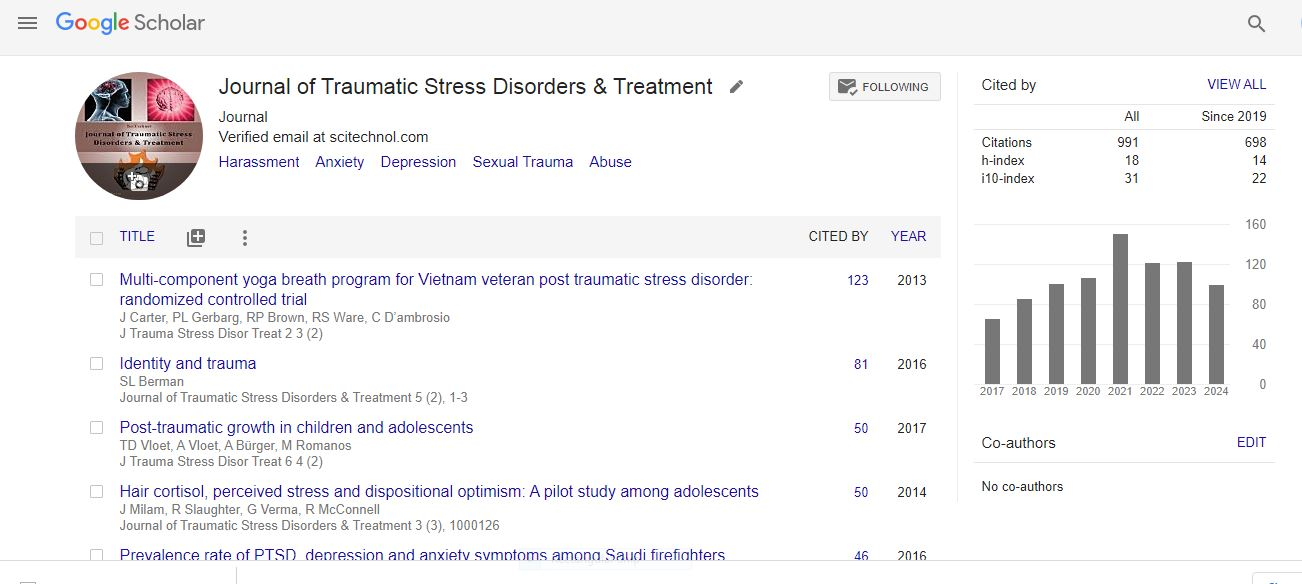Case Report, Jtsdt Vol: 13 Issue: 2
Understanding the Neurobiology of Alzheimer's Disease: Recent Discoveries and Therapeutic Strategies
Claudia Plaza*
Department of Behavioral Neurology, Stanford University, United States
*Corresponding Author: Claudia Plaza
Department of Behavioral Neurology, Stanford University, United States
E-mail: plaza08@stanford.edu
Received: 10-Apr-2024, Manuscript No. JTSDT-24-131954;
Editor assigned: 11-Apr-2024, PreQC No. JTSDT-24-131954 (PQ);
Reviewed: 23-Apr-2024, QC No. JTSDT-24-131954;
Revised: 28-Apr-2024, Manuscript No. JTSDT-24-131954 (R);
Published: 30-Apr-2024, DOI:10.4172/2324-8947.100389
Citation: Plaza C (2024) Understanding the Neurobiology of Alzheimer’s Disease: Recent Discoveries and Therapeutic Strategies. J Trauma Stress Disor Treat 13(2): 389
Copyright: © 2024 Plaza C. This is an open-access article distributed under the terms of the Creative Commons Attribution License, which permits unrestricted use, distribution and reproduction in any medium, provided the original author and source are credited
Introduction
Alzheimer's disease (AD) is a progressive neurodegenerative disorder characterized by cognitive decline, memory loss, and functional impairment. Despite decades of research, the underlying neurobiology of AD remains complex and multifaceted. Recent advances in neuroscience have shed light on the molecular and cellular mechanisms driving disease progression, leading to the development of novel therapeutic strategies aimed at halting or slowing the course of the disease. In this article, we explore the neurobiology of Alzheimer's disease, highlighting recent discoveries and emerging therapeutic approaches [1].
Amyloid-beta (Aβ) Accumulation: One of the hallmarks of Alzheimer's disease is the accumulation of amyloid-beta plaques in the brain. Aβ is derived from the cleavage of amyloid precursor protein (APP) and aggregates to form insoluble plaques, disrupting neuronal function and triggering neuroinflammation [2].
Tau Protein Hyper phosphorylation: Another characteristic feature of Alzheimer's disease is the hyper phosphorylation of tau protein, leading to the formation of neurofibrillary tangles (NFTs) inside neurons. Hyper phosphorylated tau disrupts microtubule stability, impairing axonal transport and contributing to neuronal dysfunction and cell death [3].
Neuroinflammation: Chronic neuroinflammation plays a critical role in the pathogenesis of Alzheimer's disease. Activation of microglia and astrocytes in response to Aβ accumulation leads to the release of pro-inflammatory cytokines and oxidative stress, further exacerbating neuronal damage and cognitive decline [4].
Role of the Blood-Brain Barrier (BBB): Emerging evidence suggests that dysfunction of the blood-brain barrier may contribute to the pathogenesis of Alzheimer's disease. Disruption of the BBB allows for the entry of neurotoxic substances into the brain, promoting neuroinflammation and neuronal damage [5].
Gut-Brain Axis: The gut-brain axis has emerged as a potential modulator of Alzheimer's disease pathology. Dysbiosis of the gut microbiota may influence neuroinflammation and Aβ deposition in the brain, highlighting the potential for microbiome-based interventions in AD [6].
Genetic Risk Factors: Genome-wide association studies (GWAS) have identified several genetic risk factors for Alzheimer's disease, including variants in genes involved in Aβ metabolism (e.g., APP, PSEN1, PSEN2) and immune response (e.g., TREM2). Understanding the genetic basis of AD may lead to personalized therapeutic approaches targeting specific pathways implicated in disease pathogenesis [7].
Aβ-targeted Therapies: Several therapeutic strategies aim to reduce Aβ accumulation in the brain, including monoclonal antibodies targeting Aβ aggregates (e.g., aducanumab), beta-secretase (BACE) inhibitors, and gamma-secretase modulators. While these approaches have shown promise in preclinical studies, clinical trials have yielded mixed results, highlighting the need for further investigation [8].
Tau-directed Therapies: Targeting tau pathology represents another promising avenue for Alzheimer's disease therapy. Tau-based therapies include small molecule inhibitors of tau aggregation, immunotherapies targeting pathological tau species, and gene therapy approaches aimed at reducing tau expression or promoting its clearance [9].
Neuroprotective Strategies: Neuroprotective approaches aim to mitigate neuronal damage and promote neuronal survival in Alzheimer's disease. These include anti-inflammatory agents, antioxidants, neurotropic factors, and modulators of synaptic function. While neuroprotective agents have shown potential in preclinical models, clinical translation has been challenging, highlighting the need for robust clinical trials [10].
Conclusion
Understanding the neurobiology of Alzheimer's disease is crucial for the development of effective therapeutic strategies to combat this devastating disorder. Recent discoveries in AD research have provided insights into the molecular and cellular mechanisms driving disease progression, leading to the identification of novel therapeutic targets and treatment approaches. By harnessing the power of precision medicine, neuroprotective agents, and targeted therapies, we may one day succeed in halting or slowing the progression of Alzheimer's disease, offering hope for millions of individuals affected by this debilitating condition.
References
- Hardy J, Selkoe DJ. The amyloid hypothesis of Alzheimer's disease: progress and problems on the road to therapeutics. Science. 2002;297(5580):353-6.
- Iturria-Medina Y, Sotero RC, Toussaint PJ. Early role of vascular dysregulation on late-onset Alzheimer’s disease based on multifactorial data-driven analysis. Nat Commun. 2016;7(1):11934.
- Cummings J, Lee G, Ritter A. Alzheimer's disease drug development pipeline: 2019. TRCI. 2019;5:272-93.
- Jack Jr CR, Bennett DA, Blennow K, et al. NIA-AA research framework: toward a biological definition of Alzheimer's disease. Alzheimers Dement. 2018;14(4):535-62.
- Fernandez EJ. Allosteric pathways in nuclear receptors—Potential targets for drug design. Clin Pharm Therap. 2018;183:152-9.
- Folch J, Petrov D, Ettcheto M, et al. Current research therapeutic strategies for Alzheimer’s disease treatment. Neural Plast. 2016;2016.
- Frozza RL, Lourenco MV, De Felice FG. Challenges for Alzheimer's disease therapy: insights from novel mechanisms beyond memory defects. Front Neurol. 2018;12:334515.
- Long JM, Holtzman DM. Alzheimer disease: an update on pathobiology and treatment strategies. Cell. 2019;179(2):312-39.
- Clark CM, Karlawish JH. Alzheimer disease: current concepts and emerging diagnostic and therapeutic strategies. Ann Intern Med. 2003;138(5):400-10.
- Graham WV, Bonito-Oliva A, Sakmar TP. Update on Alzheimer's disease therapy and prevention strategies. Annu Rev Med. 2017;68:413-30.
Indexed at, Google Scholar, Cross Ref
Indexed at, Google Scholar, Cross Ref
Indexed at, Google Scholar, Cross Ref
Indexed at, Google Scholar, Cross Ref
Indexed at, Google Scholar, Cross Ref
Indexed at, Google Scholar, Cross Ref
Indexed at, Google Scholar, Cross Ref
Indexed at, Google Scholar, Cross Ref
 Spanish
Spanish  Chinese
Chinese  Russian
Russian  German
German  French
French  Japanese
Japanese  Portuguese
Portuguese  Hindi
Hindi 
